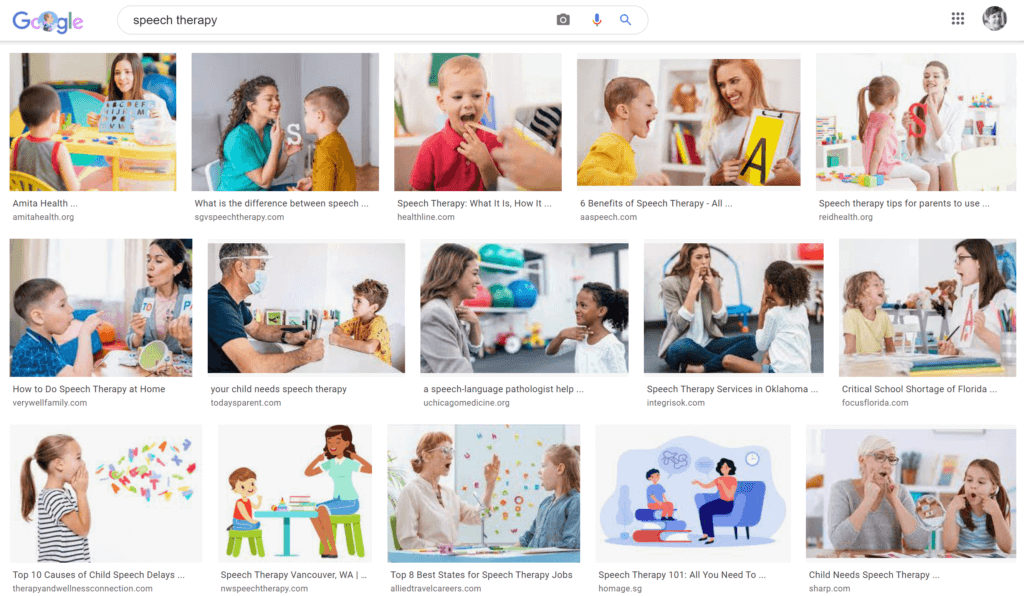One of the great ironies of speech therapy, to me, is that most people come to speech therapy by themselves.
Communication inherently involves multiple people. Most of us have to communicate with quite a wide variety of people to get through life. Communication environments are unpredictable, inconsistent, and inextricably linked to other complex human experiences like relationships, emotions, social roles, political beliefs, spirituality, and more. Communication always occurs in a tapestry of contexts.
Speech therapy, bizarrely, is most often conceived as a clinician and a participant working together one-on-one in a safe, friendly environment. Like so:

There are a number of reasons as to how and why “speech therapy” developed to be so separate from “lived communication”. A side effect of this evolution is that many people who come to speech therapy prefer to keep their experience private, isolated, and independent. How and why we communicate is highly personal, after all. Speech therapy can feel very analogous to psychotherapy. You work with a professional on your private issues, to improve your life. Your time in therapy is your thing.
Community engagement is one of our cornerstone values at speech IRL. We hire clinicians with a demonstrated track record of community involvement (from any number of diverse communities), where the impact is visible in their clinical approach. We believe passionately in the transformative power of community for those we serve. As “lived experience” becomes more prominently valued (and evidence-based) in the therapeutic professions, working solely on skills is no longer a sufficient therapy plan. Impactful speech therapy needs to support bringing your communication skills, and your whole self, by extension, into the world.
But...what if the traditional 1:1 model is what I have to work with, right now? And what if my client doesn’t WANT to have anything to do with a community, even if I think it would be great for them?
Clinicians are limited. We cannot force a client to attend a community-based activity. However, there are ways that we can begin to bring the community into traditional, individual speech therapy sessions. For clients who are very hesitant about community concepts, it’s critical to do this gradually, in a way that respects their comfort levels and need for personal privacy and safety. Here are three different “levels” of community engagement for speech therapy clients, and how speech therapy activities can support and strengthen your client’s whole-world communication experience.
Level 1: Exploration
Many speech therapy clients are hesitant to engage with a community of others who share similar journeys. They may be experiencing shame, stigma, anxiety, or a host of other difficult emotions in connection with their difference, and feel that participating in a community event will intensify these negative feelings. It’s important to validate this very natural discomfort and support the client where they are. You should not push clients to attend activities if they aren’t ready, but you can bring the community into the therapy room in safe, small ways. Together, you and the client can explore what it might be like to engage in the community, within the safe private setting of the speech therapy room.
Community exploration activities may include:
- Consume media by others about their personal journey
- Consume media by others specifically about community participation (“My first stuttering conference experience”)
- Listen to podcasts by those who share the same experience and/or identity, talking about their personal experience
- Watch videos (asynchronous or livestream)
- Research meetups, support groups, and events happening locally
All of these activities allow the client to passively engage with the stories, narratives, and culture of the community, keeping their own experiences private. These activities can be completed together during the speech therapy session, or can be assigned as homework. If using it as homework, the speech therapy session can be used to explore the client’s reaction to the stories they are seeing and hearing. Do they relate to these other folks, do these stories reflect their own experience? Do they agree or disagree with the choices and attitudes described by others? These are powerful counseling conversations that help clients contextualize their own journey and experiences.
Level 2: Participation
These activities are for clients who are willing and ready (even if they still feel a bit nervous or uncomfortable!) to engage with others who share similar experiences. Some clients may need to “work up to” this level of engagement by completing Level 1 activities first; others may naturally be more open and ready to jump right in.
Community participation activities may include:
- Attend a meetup or support group
- Log onto a live virtual event
- Attend a conference or workshop event
- Join a Clubhouse conversation
- Join a Discord server
- Post in a forum discussion or social media thread online
At the Participation level, clients may engage actively (sharing, posting, writing, speaking) or passively (listening or reading). However, the client is considered to be participating if others in the group or activity can identify the client’s presence. This is significant because the client is signalling to others, and accepting for themselves, that they identify to at least some degree with the community.
A client who logs onto a Zoom meeting but chooses to remain silent and keep their camera turned off, but listens to the conversation, is considered to be participating. Others in the Zoom call can see that the person has logged on and is present.
Many or most of these activities will need to occur outside the speech therapy session, due to timing and logistics. As with Exploration, though, these activities are excellent material for speech therapy. Session time can be used to “post-process” the client’s experience and discuss whether or not they see themselves continuing to engage in community activities. Not all clients have positive experiences when engaging with shared communities like this, so be prepared to guide your client through validating reflection no matter what kind of takeaways they have. If your client felt like this community was not for them, ask them what disconnects they identified, and invite them to consider if there might be alternate groups of individuals who have more similar experiences.
Level 3: Change
This level of community engagement occurs once a speech therapy client has been actively participating in community activities, and begins to use their role in the community to take on new opportunities and challenges. The person has embraced their role within the community and is in a positive feedback loop of being changed and proactively creating continued positive change for themselves, with an entire network of supporters to encourage them.
Community change activities may include:
- Lead a meeting or discussion
- Serve as a panelist at community event or class for professional students-in-training
- Be interviewed on a podcast or livestream
- Post about stuttering on social media (TikTok, Insta story, FB Live)
- Give a presentation about stuttering
Similar to Participation activities, the bulk of these activities by nature take place outside of the speech therapy room. However, many of these activities benefit from communication preparation, which makes for excellent speech therapy material! Speech therapy can be used to help the client craft their message, rehearse a speech or presentation, or practice Q&A. Depending on what kind of support the client wants from you, speech therapy could address the content of the message, the behavioral delivery of the message (speech, voice, etc.), or both.
And of course, make sure to dedicate speech therapy time to post-processing and celebrating your client’s achievement once the activity is done! These are ideal moments to invite clients to reflect on their entire journey, and how they may continue to grow and change in the future. “Do you think your old self would have believed you would speak on a panel like that?” “This was such a cool accomplishment - how did you get here? What has this taught you about yourself?”
Speech therapy: bridging connections
All people who attend speech therapy are “different” in some way. That difference may be solely connected to communication, or it may encompass numerous aspects of life. Difference is often isolating, and it’s common for many speech therapy clients to feel that they are the only person they know who is struggling with their particular experience. While it’s normal for many speech therapy clients to have a desire to keep their communication work and struggles private, relegating communication work to just the speech therapy session will limit their potential to carry skills into the real world.
Communication is an inherently social activity, requiring engagement with others, meaningful progress cannot be achieved in speech therapy without this same social engagement. There are so many ways that we can bring social engagement into therapy, as a bridge to help our speech therapy clients go out into the world. As clinicians, we need to recognize that community engagement is not merely a bonus class of “extra” therapy activities to do when the weather is nice or when the client is bored with traditional activities. Community is where communication happens, and should be the foundation upon which we build every other treatment goal and therapy activity.
Are you passionate about community, or curious to learn more about how to apply this in speech therapy? Join us for our CE event on how to integrate professional allyship and community participation in speech therapy.

